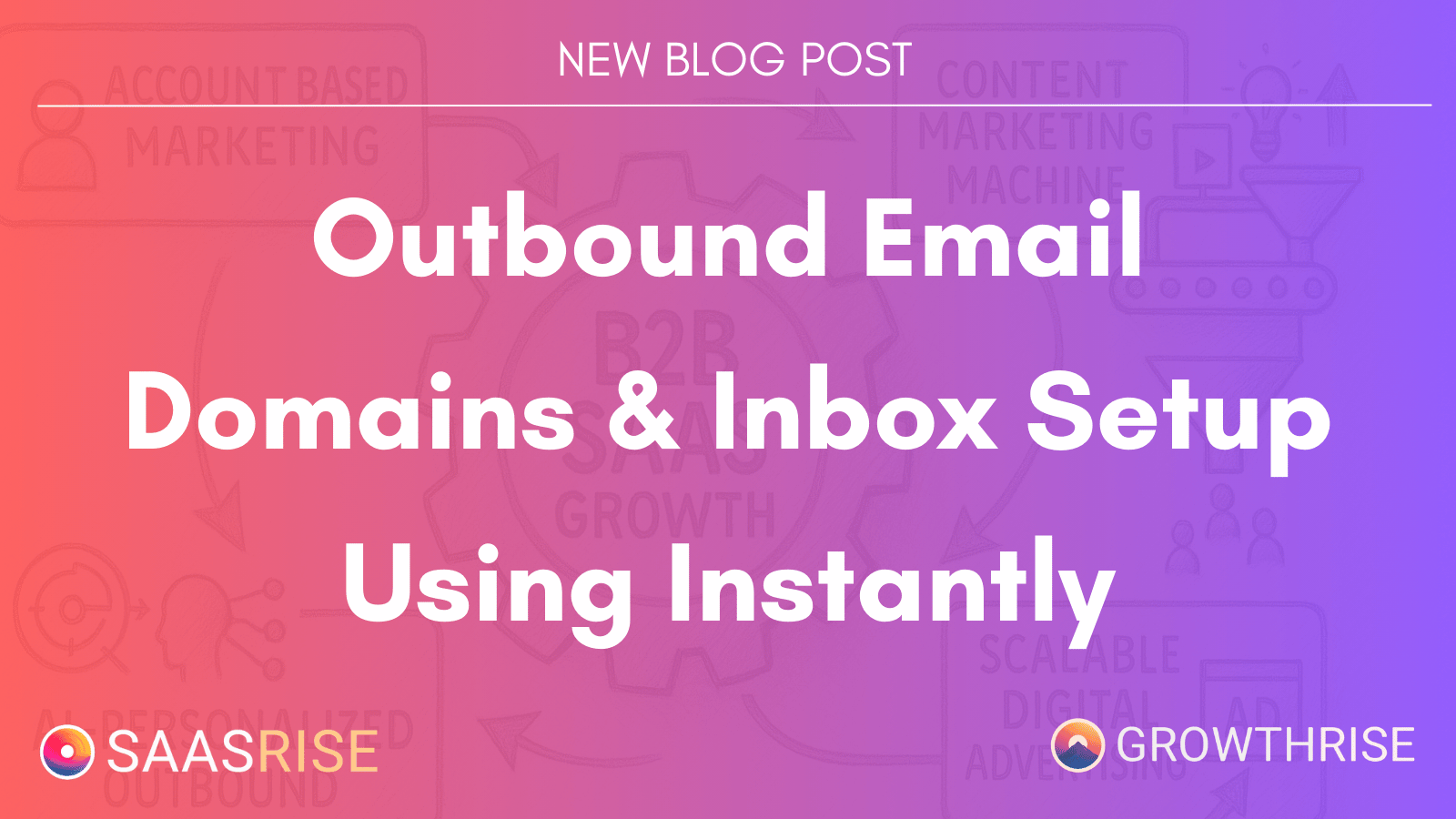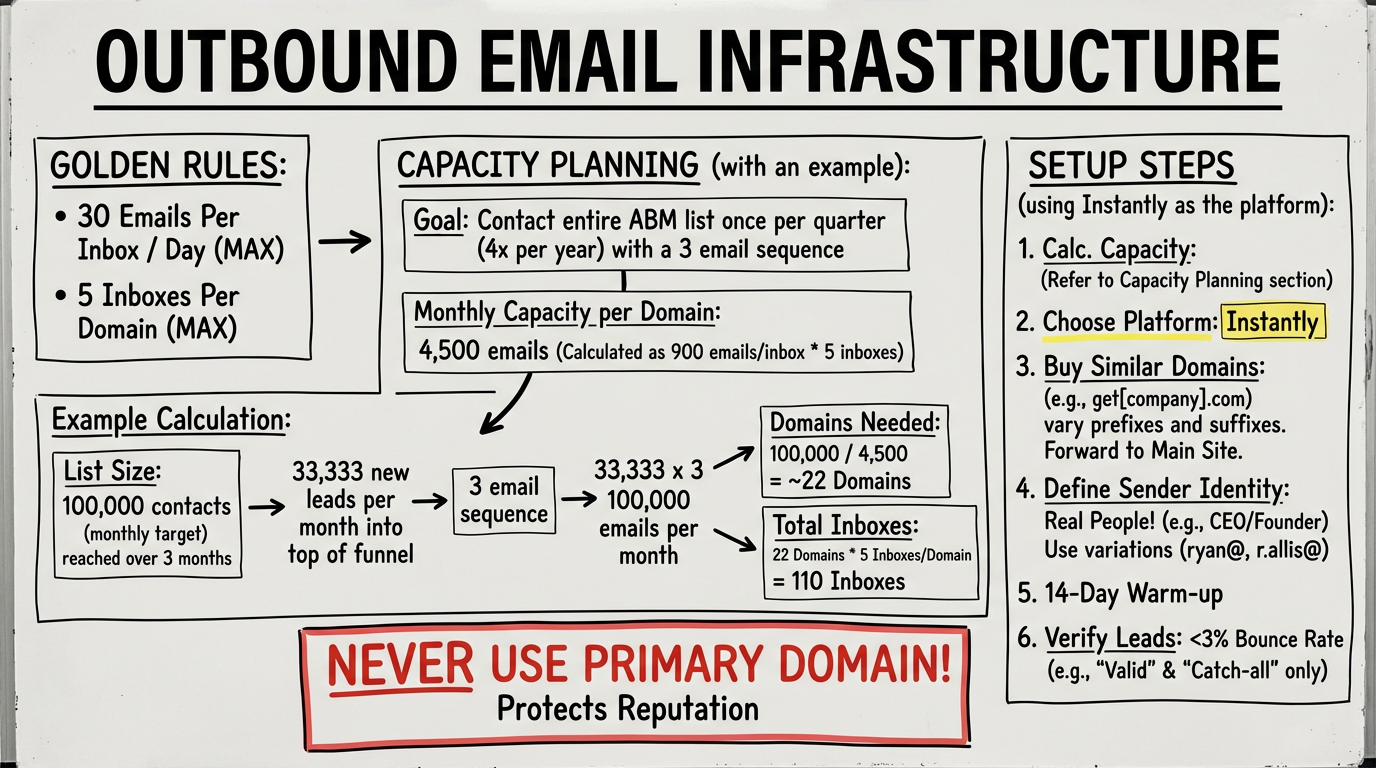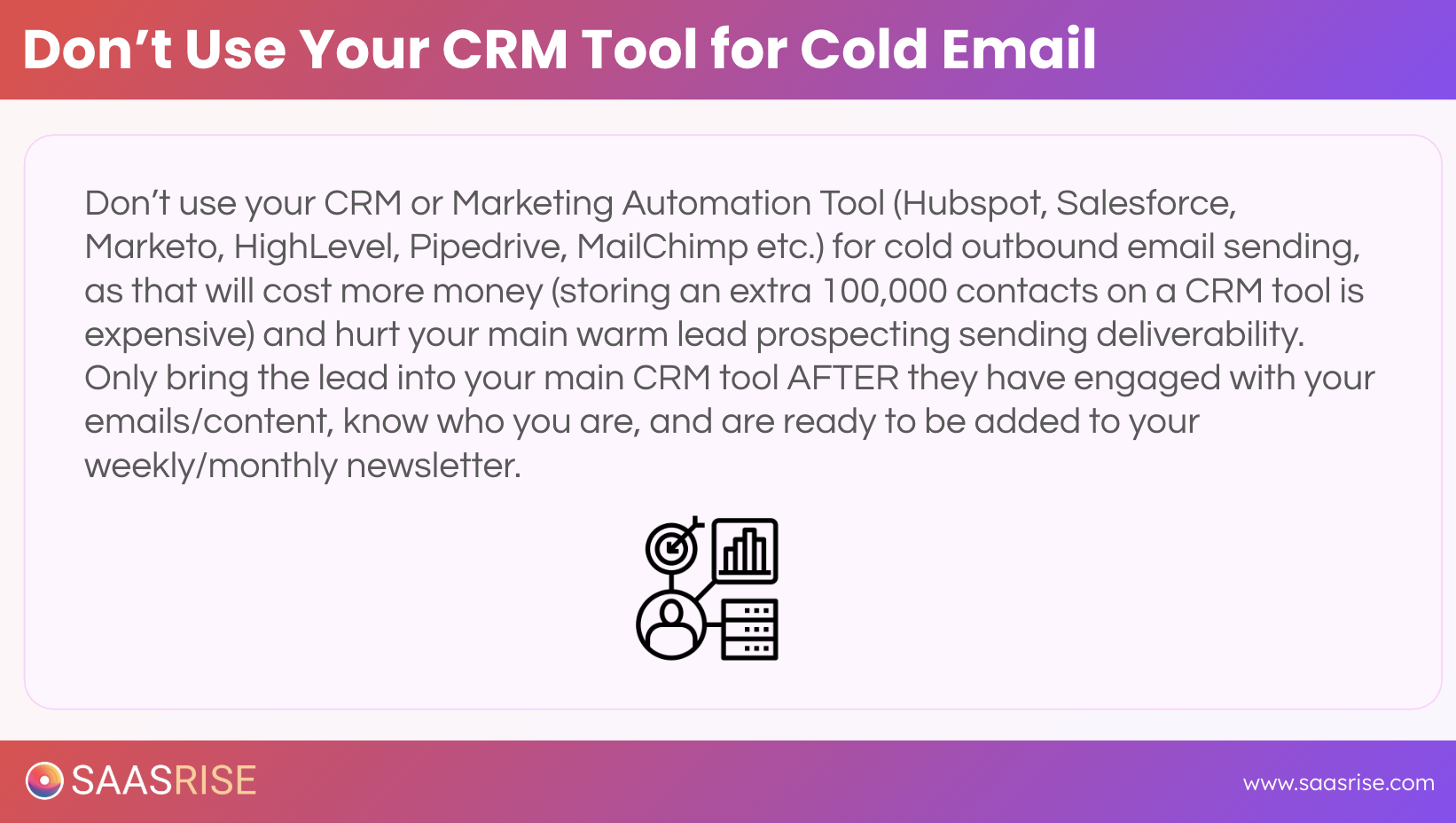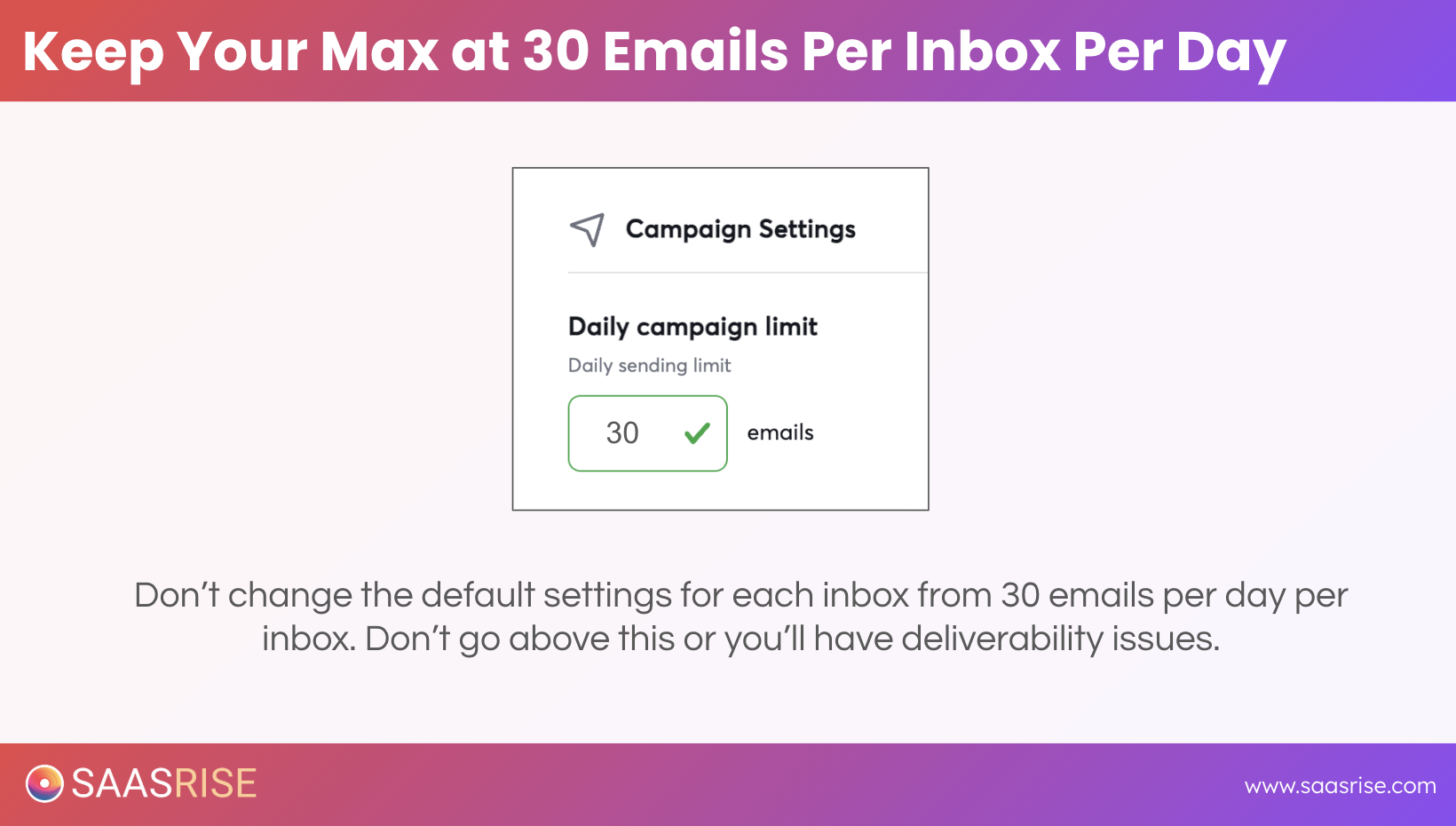
Outbound Email Domains & Inbox Setup Using Instantly
Every successful outbound program begins long before the first email is ever sent. In B2B marketing, the technical groundwork — domains, inboxes, authentication, and reputation management — determines whether your carefully crafted messages ever make it to the inbox.
Most SaaS teams obsess over copywriting and sequencing, but overlook the mechanics that make deliverability possible. It’s a little like launching a world-class campaign from a broken runway. You can have the best aircraft and pilots, but if the tarmac is cracked, you’re not getting off the ground.
In the world of outbound, that runway is your email infrastructure. And the control tower — the tool that simplifies the whole process — is often Instantly, a platform built to manage cold-email sending, verification, and warm-up at scale.

Why Infrastructure Determines Growth
Outbound email is one of the most efficient ways to scale pipeline for SaaS companies with a defined ICP. It can reach thousands of decision-makers with a minimal budget compared to ads or events. Yet, results depend entirely on trust.
Internet service providers treat every email domain as a reputation-based identity. When that identity sends too many unverified or irrelevant messages, the system assumes it’s spam. Once flagged, even legitimate messages get buried in the promotions tab — or vanish entirely.
Good outbound isn’t just about persuasive messaging. It’s about convincing Google, Microsoft, and every other email gatekeeper that your messages deserve to land in the inbox. That begins with the domains and inboxes you use.
From ABM List Building to Outbound Readiness
Before building infrastructure, you need to know who you’re reaching out to. The groundwork for outbound always begins with Account-Based Marketing (ABM) — defining the accounts that fit your Ideal Customer Profile and collecting verified contact data from platforms such as Apollo, ListKit, and Clay.
Outbound email is simply the next stage of that system. Once the ABM list is finalized and verified, the question becomes: How do we reach these people reliably, at scale, without destroying our sender reputation?
That’s where domain and inbox strategy enters. Outbound infrastructure transforms a static ABM list into a living, breathing distribution network that connects your product with decision-makers.
The Evolution of Outbound Email
Five years ago, setting up outbound was painful. Marketers had to manually buy domains, connect inboxes, verify DNS records, install warm-up software, and maintain spreadsheets to track what was working.

Today, tools like Instantly have compressed that entire workflow into a few clicks. But even with automation, the strategy remains the same:
- Protect your main domain.
- Use multiple secondary domains to distribute volume.
- Keep inboxes human-like in behavior.
- Warm them before sending.
This isn’t busywork; it’s the foundation for scale. Once established, the system allows you to send thousands of personalized messages a month with consistency and confidence.
Why You Need More Than One Domain
Think of a domain like a passport. Each one carries its own reputation. If you send every cold email from your company’s main domain, one misstep — high bounce rate, spam complaints, or broken links — can jeopardize your entire corporate identity.
Outbound-specific domains act as a buffer. They carry the same branding but operate independently, protecting your main site while giving you freedom to experiment.
Many companies use variations of their name:
growthriseapp.comgrowthrisemail.comtrygrowthrise.comgrowthrise.co
These variations look legitimate, but they isolate risk. If one domain experiences a deliverability issue, the others remain unaffected.

Inbox Multiplication: Small Batches, Big Volume
Reputation is built on behavior. Sending thousands of emails from a single inbox looks suspicious to spam filters. Instead, outbound systems distribute volume across many inboxes, each sending modest amounts per day — 20, 30, maybe 40 messages.
At scale, ten or twenty inboxes working together can quietly and safely reach tens of thousands of prospects every month.
What matters most is consistency. An inbox that sends small, steady volumes builds trust over time. One that spikes suddenly will raise red flags. Deliverability loves moderation.
The Warm-Up Period: Teaching the Internet to Trust You
Warm-up is the silent phase of outbound — the two weeks where nothing visible happens, yet everything important does. During this time, automated systems send and receive low-volume emails between trusted networks, simulating human conversation.
These exchanges teach email providers that your new inboxes behave like real users: sending reasonable amounts, replying, opening, and marking messages as important.

Skipping warm-up is like entering a marathon without stretching. You might start strong, but you’ll burn out quickly.
Marketers who take the full 14-day warm-up window usually see their messages consistently land in primary inboxes. Those who rush it often end up rebuilding their infrastructure from scratch.
Deliverability Is a Reputation Game
Every decision you make — from list hygiene to sending times — affects deliverability. Some guiding truths apply universally:
- Low Bounce Rates protect your domain’s trust. Always verify lists.
- Relevance beats volume. Fewer, well-targeted emails outperform generic blasts.
- Human Timing matters. Weekday mornings get better engagement than weekends.
- Consistency keeps you safe. Sudden spikes look unnatural.
- Engagement Signals (opens, replies, clicks) strengthen reputation.
Deliverability is dynamic. It’s not just technical — it’s behavioral. Email providers reward senders who communicate responsibly and consistently.
How Instantly Simplifies the Process
Instantly emerged as the cold-email platform that merged all the moving parts into one environment: list verification, inbox management, sequencing, and AI personalization.
Its innovation wasn’t in reinventing email — it was in combining dozens of previously disconnected tools. Instead of juggling SMTP setups, warm-up software, and Excel trackers, marketers could now handle everything from one dashboard.
Instantly automates:
- Domain purchasing and DNS setup.
- Inbox creation and rotation.
- Warm-up and reputation monitoring.
- Bounce verification and suppression.
- Sequence scheduling and A/B testing.
That automation saves teams hundreds of hours, but the underlying discipline — maintaining clean data, relevant targeting, and measured volume — remains the marketer’s responsibility.

The Art of Sender Identity
Who your emails come from is as important as what they say. In B2B, authenticity drives trust.
Recipients are far more likely to open messages from real people than from faceless company accounts. A note from “Ryan at GrowthRise” feels personal. A message from “info@growthrise.com” feels automated.
For most teams, the best sender is:
- A recognizable leader, such as the CEO or Head of Sales.
- Someone with an active LinkedIn presence.
- A consistent persona across campaigns.
The sender becomes part of your brand’s voice. Over time, prospects begin to associate the name with expertise and credibility — a crucial step in turning cold outreach into warm recognition.
Cold vs. Warm Email Ecosystems
It’s important to separate cold outbound systems from your company’s main CRM or newsletter platforms. Cold outreach operates in a different universe, with its own rules and risk management.
- Cold systems (like Instantly) are built for cautious volume, rotating inboxes, and gradual reputation building.
- Warm systems (like Beehive, HubSpot, or Mailchimp) are optimized for scale and frequency — ideal for newsletters and existing subscribers.
Mixing them is dangerous. Sending cold messages from your primary marketing domain can ruin your ability to send any email at all. Keeping them separate protects both ecosystems.
Managing Volume Like a Pro
Outbound isn’t about blasting every contact at once. It’s a marathon of steady touchpoints.
The best campaigns space messages out, reaching an entire target market once per quarter through short, high-value sequences.
Teams that try to compress months of communication into a single week inevitably hit spam filters. Those that pace themselves create sustainable awareness.
A good rhythm often looks like:
- Three to five emails per sequence.
- Two or three days between messages.
- New campaigns every three to four months.
That cadence mirrors human conversation — persistent but polite.
Personalization in the Era of AI
A few years ago, personalization meant merging a first name and company name into a template. Today, AI makes it possible to create individualized introductions for thousands of leads, referencing public data, recent achievements, or company news.
Tools like Instantly now integrate directly with AI platforms to generate custom intros, subject lines, and PS notes at scale.
Personalization no longer needs to slow teams down. Done right, it enhances relevance and keeps engagement rates high without sacrificing speed.
The rule of thumb: if an email feels like it was written by a human who understands the recipient’s world, it will perform better — regardless of how it was generated.
Offer Design and Value Exchange
Cold email isn’t just outreach; it’s the first handshake of a potential partnership. The strength of that handshake depends on what you’re offering.
Successful campaigns often include something genuinely valuable — not a hard sell, but an invitation. Examples include:
- A free trial or extended demo period.
- Access to exclusive content or research.
- A personalized audit or strategy session.
- A relevant case study.
When recipients feel they’re gaining more than they’re giving, response rates rise dramatically. Offers that sound transactional or self-promotional rarely work in outbound contexts.
Creating Awareness Through Repetition
Outbound should never be viewed as a one-time event. It’s part of a continuous ecosystem of touchpoints — email, LinkedIn, ads, and content.
The purpose isn’t always immediate conversion. It’s awareness. Each email that lands in an inbox builds mental real estate. Over time, consistent exposure across channels turns cold prospects into warm audiences.
Marketers who understand this treat outbound like advertising: frequency and consistency create familiarity, and familiarity breeds trust.
Metrics That Matter
With outbound, the goal isn’t vanity metrics like open rates — it’s pipeline creation. Still, certain benchmarks signal healthy performance:
- Deliverability: Above 90%.
- Bounce Rate: Under 3%.
- Open Rate: 50–70%, depending on targeting.
- Click-Through Rate: 2–5%.
- Reply Rate: 0.5–1%.
Numbers fluctuate, but trends matter more than snapshots. Declining deliverability signals a domain issue. Stable engagement indicates reputation strength.
Scaling Responsibly
Outbound is scalable, but not infinitely. When teams try to double volume overnight, domains get burned. Smart marketers expand gradually, adding new inboxes, warming them properly, and maintaining rest cycles for older ones.
Many compare this to crop rotation. Just as farmers rest fields to keep soil fertile, outbound teams rest inboxes to preserve deliverability. Letting a subset of inboxes “breathe” each quarter restores their reputation and keeps performance steady over time.
Integrating Warm and Cold Worlds
The magic happens when outbound and inbound systems meet. Every click or reply from a cold campaign can flow directly into CRM pipelines, retargeting audiences, and warm newsletters.
The cycle looks like this:
- ABM list feeds Instantly for cold outreach.
- Engaged leads sync to HubSpot or Beehive.
- Warm campaigns nurture those relationships.
- Ads on LinkedIn or Meta reinforce brand presence.
Each channel amplifies the others, forming a continuous loop of engagement — from first touch to customer retention.
Common Pitfalls to Avoid
Even seasoned teams fall into these traps:
- Sending before warming inboxes properly.
- Using unverified lists with high bounce rates.
- Ignoring domain authentication.
- Sending from non-human or generic addresses.
- Treating cold email as a one-off blast instead of a long-term system.
- Neglecting engagement signals or rest periods.
Outbound success isn’t about doing one thing perfectly. It’s about avoiding the dozen small mistakes that quietly erode reputation.
The Human Element Behind Automation
While tools like Instantly automate infrastructure, the heart of outbound remains human. The tone of your emails, the empathy in your outreach, and the genuine curiosity about your prospect’s business all matter.
Automation handles the logistics, but people build relationships. The most effective campaigns balance precision technology with authentic communication.
From Setup to Strategy
Once your outbound system is live, the real work begins — testing, measuring, iterating. The best teams treat every campaign as an experiment.
They adjust sending schedules, rewrite subject lines, and refine offers. They compare engagement between domains. They monitor reputation scores like scientists tracking data points.
The difference between average and exceptional outbound programs isn’t the number of tools used — it’s the rigor of their feedback loop.
Outbound as a Long-Term Growth Engine
The companies that master outbound don’t view it as a temporary channel. They build it into their marketing DNA.
When you combine ABM precision with outbound consistency, the system becomes self-reinforcing. Each campaign strengthens domain reputation, grows your warm list, and amplifies brand awareness.
Over time, your email domains become assets — trusted identities that open doors instead of being blocked by spam filters.
The Instantly Advantage
Instantly’s biggest contribution to the outbound landscape is simplicity. It turns what used to be a maze of DNS records, manual verifications, and spreadsheet chaos into a streamlined experience.
It lets marketers focus on strategy — on message, targeting, and value — while automating the technical complexity beneath the surface.
For fast-growing SaaS teams, that means less time troubleshooting and more time selling. And in an environment where every missed inbox equals a missed opportunity, that efficiency compounds into real revenue.
The Bigger Picture
Outbound email is more than a sales tactic; it’s the connective tissue between awareness and conversion. It creates first impressions, reinforces brand authority, and fills the pipeline with intent signals long before ads or SDR calls take over.
Getting it right doesn’t require genius — just discipline: clean lists, good data, authentic messages, and a respect for the rules of deliverability.
Tools like Instantly make the process accessible. Strategy makes it powerful.
Conclusion
Cold email has evolved from a scrappy growth hack into a structured, data-driven discipline. And at the center of that discipline lies infrastructure — domains, inboxes, and the invisible systems that build trust at scale.
Setting up outbound with Instantly isn’t just a technical exercise; it’s a declaration that your company takes communication seriously. It means you’re willing to build the foundation before chasing the metrics, to earn reputation before expecting results.
In a digital world where reputation determines reach, that patience pays off. Because when your domains are healthy, your inboxes are trusted, and your emails consistently reach the right people — outbound stops being noise. It becomes presence.
And presence, over time, becomes growth.

